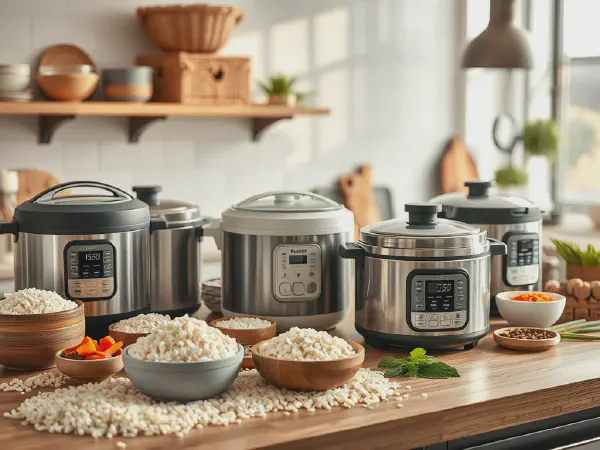The Ultimate Guide to Finding the Best Rice Cookers

Everything You Need to Know About Rice Cookers
Rice cookers are a must-have appliance in any kitchen. They offer a convenient and foolproof way to cook perfect rice every time. Whether you're a seasoned chef or an amateur cook, a rice cooker can greatly simplify the cooking process and help you achieve consistently delicious results.
In this article, we will explore the different types of rice cookers, the key features to consider when buying one, the benefits of using a rice cooker, tips for cooking perfect rice, and how to clean and maintain your rice cooker. We will also discuss some delicious recipes that you can make with a rice cooker. So let's dive in and discover the wonders of this essential kitchen appliance.
Different Types of Rice Cookers
When it comes to rice cookers, there are several different types available on the market. Each type has its own unique features and benefits. Let's take a closer look at some of the most popular types of rice cookers.
Electric Rice Cookers: Electric rice cookers are the most common type of rice cooker found in households. They are easy to use and have a simple one-touch operation. These cookers come in a range of sizes and can cook different types of rice, from white rice to brown rice and even sushi rice. They are also equipped with a keep warm function, which helps to keep the rice warm and fresh for extended periods.
Different Types of Rice Cookers
Microwave Rice Cookers: Microwave rice cookers are a convenient option for those who want to cook rice quickly. These cookers are designed to be used in the microwave and can produce perfectly cooked rice in just a few minutes. They are compact and easy to clean, making them ideal for small kitchens or for those who don't have a lot of storage space.
Discover the Best Rice Cookers for your kitchen needs today!
Induction Rice Cookers: Induction rice cookers use electromagnetic technology to heat the cooking pot. This allows for faster and more precise cooking. These cookers are known for their energy efficiency and ability to cook rice evenly and thoroughly. They also have a wide range of cooking functions, making them versatile for various recipes.
Pressure Rice Cookers: Pressure rice cookers are designed to cook rice under high pressure, resulting in faster cooking times and more tender rice. These cookers are great for those who are short on time but still want perfectly cooked rice. They are also suitable for cooking other grains and can be used as a multi-purpose kitchen appliance.
Features to Consider When Buying a Rice Cooker
Capacity: The capacity of a rice cooker is an important factor to consider, especially if you frequently cook for a large family or group. Rice cookers come in various sizes, ranging from small 3-cup cookers to large 10-cup cookers. Choose a size that suits your needs.
Cooking Modes: Some rice cookers come with multiple cooking modes, allowing you to cook different types of rice and even other dishes like steamed vegetables or porridge. Look for a rice cooker with versatile cooking modes to expand your culinary options.
Keep Warm Function: A keep warm function is a handy feature that keeps the cooked rice warm and fresh for an extended period. It prevents the rice from drying out and allows you to enjoy hot rice whenever you're ready to eat.
Delay Start: If you lead a busy lifestyle, a rice cooker with a delay start function can be a game-changer. This feature allows you to set a specific time for the rice cooker to start cooking, so you can come home to freshly cooked rice.
Easy Cleaning: Look for a rice cooker with a removable, non-stick inner pot for easy cleaning. Some rice cookers also have dishwasher-safe parts, making cleanup a breeze.
Non-Stick Inner Pot: A non-stick inner pot is essential for preventing rice from sticking and burning. It also makes it easier to clean the rice cooker after use.
Automatic Shut-Off: An automatic shut-off feature ensures that the rice cooker turns off automatically when the rice is fully cooked. This helps to prevent overcooking or burning of the rice.
Multi-Functionality: If you're looking for a versatile kitchen appliance, choose a rice cooker that offers additional functions like steaming, slow cooking, or soup making. This allows you to make a variety of dishes with just one appliance.
Benefits of Using a Rice Cooker
Consistent Results: One of the key benefits of using a rice cooker is that it delivers consistent results every time. The cooker is programmed to cook rice to perfection, taking the guesswork out of the cooking process.
Time-Saving: Cooking rice on the stovetop can be time-consuming, especially when you have other dishes to prepare. A rice cooker allows you to set it and forget it, freeing up your time for other tasks.
Convenient: Rice cookers are incredibly convenient to use. Simply add rice and water, press a button, and let the cooker do the rest. You don't need to monitor the cooking process or worry about the rice boiling over.
Versatile: In addition to cooking different types of rice, rice cookers can also be used to make a variety of other dishes such as steamed vegetables, porridge, soups, and even desserts.
Energy-Efficient: Rice cookers are designed to be energy-efficient, using just the right amount of heat to cook the rice. This helps to save energy and reduce utility bills.
No Monitoring Required: Unlike cooking rice on the stovetop, rice cookers require no monitoring. Once you press the button, the cooker will take care of the rest, ensuring perfectly cooked rice without any effort on your part.
Tips for Cooking Perfect Rice in a Rice Cooker
Measuring the Rice and Water Ratio: The ratio of rice to water is crucial for achieving perfectly cooked rice. As a general rule, use 1 cup of rice to 1.5 cups of water for most types of rice. Adjust the ratio according to your preference or the type of rice you're using.
Soaking the Rice: Soaking the rice for 15-30 minutes before cooking can help improve its texture and reduce cooking time. However, this step is optional and may not be necessary for some types of rice.
Adding Seasoning: To enhance the flavor of your rice, you can add a pinch of salt or other seasonings like herbs, spices, or even bouillon cubes to the cooking water.
Choosing the Right Cooking Mode: Different types of rice require different cooking methods. For example, sticky rice may require a different cooking mode than jasmine rice. Refer to the rice cooker's manual for guidance on selecting the appropriate cooking mode for the type of rice you're cooking.
Letting the Rice Rest: After the rice cooker has finished cooking, let the rice rest for a few minutes before fluffing it with a fork. This allows the excess moisture to evaporate, resulting in fluffier rice.
Cleaning and Maintenance of Rice Cookers
Cleaning the Inner Pot: After each use, remove the inner pot from the rice cooker and wash it with warm, soapy water. Avoid using abrasive scrubbers that could damage the non-stick coating.
Removing Stains and Odors: To remove stains or odors from the inner pot, you can soak it in a mixture of vinegar and water or baking soda and water. Let it sit for a few hours before rinsing thoroughly.
Descaling: Over time, mineral deposits may build up on the heating element and inner pot. To descale your rice cooker, fill it with a mixture of vinegar and water and run a complete cooking cycle. Rinse thoroughly afterward.
Proper Storage: When not in use, make sure to store your rice cooker in a clean and dry place. Avoid stacking heavy objects on top of it to prevent damage.
Recipes You Can Make with a Rice Cooker
Steamed Vegetables: Place a steaming basket in the rice cooker and add your favorite vegetables. Add water to the pot, close the lid, and select the steaming mode. In a few minutes, you'll have perfectly steamed vegetables.
One-Pot Meals: Rice cookers are great for making one-pot meals. Simply add rice, vegetables, meat, and seasoning to the pot, select the appropriate cooking mode, and let the cooker do its magic.
Porridge: Rice cookers are perfect for making creamy porridge. Add rice, water or milk, and your choice of sweeteners or flavorings to the pot. Select the porridge mode and let it cook until the desired consistency is achieved.
Quinoa: Quinoa can be cooked perfectly in a rice cooker. Rinse the quinoa, add it to the pot with water, and select the appropriate cooking mode. In no time, you'll have fluffy and nutritious quinoa.
Risotto: Making risotto can be labor-intensive, but a rice cooker simplifies the process. Sauté the ingredients in the rice cooker, add the rice and broth, and select the risotto mode. Stir occasionally, and you'll have a creamy and delicious risotto.
Sushi Rice: Sushi rice requires precise cooking, and a rice cooker can achieve the perfect texture every time. Rinse the rice, add it to the pot with water, and select the sushi rice mode.
With these recipes and tips in mind, you can make the most out of your rice cooker and enjoy a variety of delicious dishes beyond just plain rice. Experiment with different ingredients and flavors to create your own culinary wonders.
